11 Chef-Approved Substitutes For Ranch Dressing
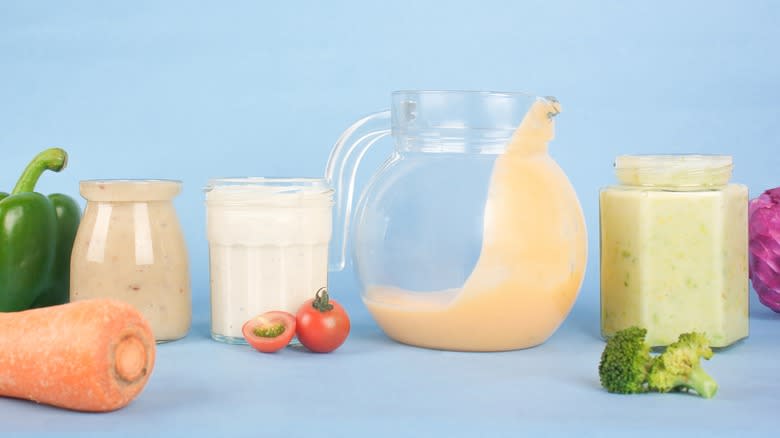
It would be hard to imagine a world without ranch dressing. This creamy, ivory-hued, herb-infused sauce, made from mayonnaise, buttermilk, and a blend of herbs and spices, has become a staple of vegetable dippers, salad eaters, and chicken wing lovers from coast to coast, since its invention in the 1940s. According to Statista, ranch is the most popular prepared salad dressing in the US by a landslide, with 143.21 million users annually, more than double the next most commonly consumed choice, namely Caesar. While ranch is incredibly versatile, being capable of doctoring up everything from a classic pasta salad to a rustic potato salad, it can get a bit monotonous and sometimes you need to switch things up.
As a chef with nearly 18 years of professional experience, I have made my own ranch dressing and have certainly used it on countless occasions, but I find myself craving more. I prefer flavors that are more bold, distinct, and complex. For this reason I have sought to expand my salad dressing repertoire, searching for flavors and textures that would give my guests that satiety component and dunkability that ranch has, with that "wow" factor that won't leave them missing this household staple. Read on to discover my chef-approved substitutes for ranch dressing for all of your dressing, dunking, and dipping needs.
Read more: 14 Liquids To Add To Scrambled Eggs (And What They Do)
Soft-Boiled Eggs With Lemon Juice, Mustard, And Fresh Herbs

One of the key elements that makes ranch dressing so appealing is its luscious texture, which is largely attributable to a hefty amount of mayonnaise. But there is another ingredient that can achieve this luxurious texture with less fat and all the flavor: a soft-boiled egg. A soft-boiled egg has a white that is fully set, and a yolk that is almost jam-like in texture. When puréed together with bright, acidic ingredients, like lemon juice, a peppery emulsifier, like Dijon mustard, and verdant fresh herbs, like tarragon and dill, a flavorful dressing akin to a classic French sauce gribiche is achieved.
The key is making a perfectly yolky soft-boiled egg, which may seem intimidating to do, but is less challenging than you think. First, this is not the time to use the freshest eggs you can find. You will discover that ultra fresh eggs are exceedingly challenging to peel. Next, bring a pot of water to a boil and gently place the raw eggs into it. Reduce the heat to a moderate boil and allow the eggs to cook for about six minutes before transferring them to an ice water bath. Once the eggs have cooled, you can easily peel them -- I found the tape hack for peeling eggs actually works surprisingly well -- and whiz them together for a dressing that is sure to satisfy all your needs.
Tahini With Miso, Honey, And Fresh Ginger

Another ingredient that can handily replace mayonnaise when it comes to obtaining a velvety texture for salad dressing is one that is intensely flavorful and somewhat exotic: tahini paste, which is made from pulverized sesame seeds. It is perhaps best known for playing a starring role in any classic hummus recipe, but its utility goes far beyond the popular dip. It is often turned into a dipping sauce or dressing in various Middle Eastern culinary traditions for delicacies, like falafels.
When working with tahini paste, it is important to know that it easily separates in the jar the same way natural peanut butter does. Before using tahini in a dressing, make sure you whisk it together thoroughly to obtain a creamy versus grainy texture. For a delightful combination that marries Asian flavors with this Middle Eastern staple, mix together umami-rich miso paste, honey, and freshly minced ginger. The ideal miso for this is the shiro or white variety, which is fermented for a shorter period of time, making it milder and sweeter than its darker counterparts. This sweet and savory concoction is perfect for accentuating crunchy vegetables and drizzling over roasted ones, and it makes for a dynamite pairing with spicy chicken wings.
Cream Cheese With Apple Cider Vinegar, Honey, And Everything Bagel Seasoning
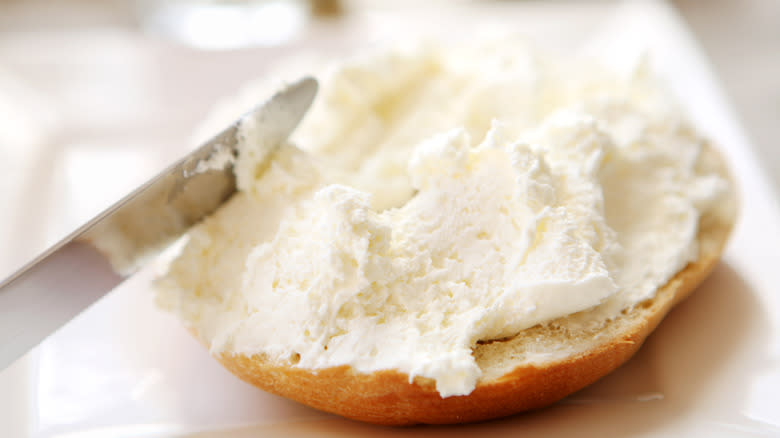
When thinking about the primary characteristics of ranch dressing, its tanginess, conferred by the buttermilk, comes to mind. An ingredient that has this zing, while also being capable of adding the richness of mayonnaise to dressing, is cream cheese. Cream cheese may have a reputation as the ultimate topping for a carrot cake or for smearing onto a chewy bagel, but its usefulness in recipes is multifold. When softened, it becomes incredibly malleable and capable of binding together harmoniously with a host of ingredients.
When it comes to transforming cream cheese into a salad dressing, simply whiz the softened block together in a food processor with an acid, like apple cider vinegar, and a hint of sweetness, such as honey or maple syrup, to help balance out the sharpness of the inherent tartness of this dairy product. Then you can get creative with your spices. I like to take a cue from that authentic New York deli bagel by incorporating some everything bagel seasoning. This blend contains kosher salt, black and white sesame seeds, poppy seeds, and minced, dried garlic and onion, for an aromatic combination that is perfect for adorning any salad or dipping everything from pizza to breadsticks into.
Whipped Cream With Mustard, Lemon Juice, And Herbes De Provence
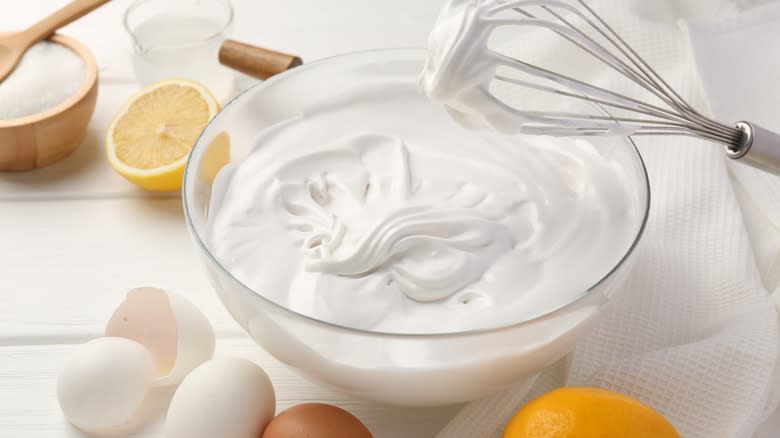
For a distinctly sophisticated creamy dressing with classic French influence, try whisking up a recipe using heavy whipping cream. It may seem unconventional, bizarre even, to use whipped cream in salad dressing, but the technique is sound. But before you go out and purchase a bucket of Cool Whip, hold up. This method requires using the real deal: heavy whipping cream from a carton. The key is whisking the cream together with the ingredients, either by hand or using a stand mixer, until soft peaks are formed. What results is a decadent, luxurious, creamy concoction that has all the volume and flavor, with an added hint of fluffiness, that beautifully kisses delicate greens without weighing them down the way ranch dressing often can.
In keeping with French tradition, I recommend blending the heavy whipping cream with lemon juice, Dijon mustard, and herbes de Provence, which is a blend of aromatics from the Provence region of France. It takes advantage of the abundant variety of herbs that grow in the region. The combination of dried herbs usually appearing in this blend include thyme, savory, tarragon, rosemary, marjoram, and sometimes lavender. It is one of my favorite herb blends to use in virtually any recipe, but when added to this salad dressing, it instantly transports you to the south of France.
Pumpkin Purée With Champagne Vinegar, Maple Syrup, And Chinese Five Spice
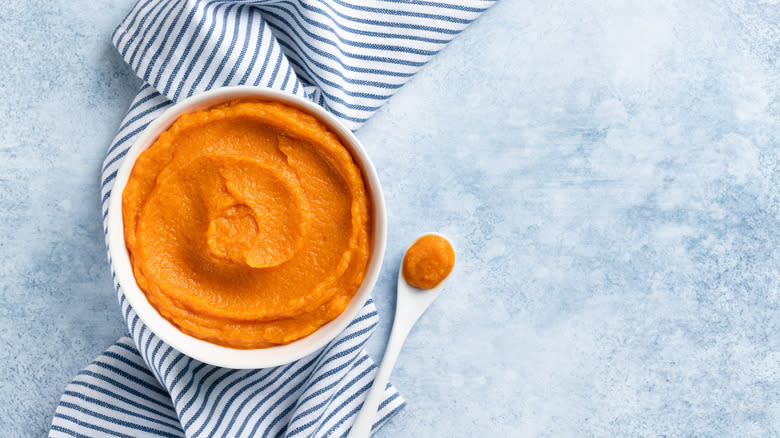
While ranch is decidedly savory in flavor profile, there is no reason a dressing with a sweet taste that has a luxurious texture cannot be a perfect substitute, particularly when making salads or searching for something to dip spicy chicken wings into. One of my favorites solves several conundrums simultaneously, by using leftover pumpkin purée that you may have from baking a pie at Thanksgiving and creating a dressing that is loaded with fiber, nutrients, and is notably lower in fat. But most importantly, it is delicious.
The key is to use plain pumpkin purée, not pumpkin pie mix, which is pre-sweetened and spiced. Combine the pumpkin with champagne vinegar, maple syrup, and Chinese five spice, or another sweet spice blend, such as apple or pumpkin pie spice, for a dressing that is reminiscent of fall flavors. I opt for Chinese five spice over other sweet spice blends because of its distinct combination of flavors. This blend typically contains Szechuan peppercorns, ground cloves, fennel, cinnamon, and star anise, but may vary depending upon where you source it. Its distinct spicy, earthy, and sweet flavors enhance sweet and savory recipes alike, and are a stellar addition to this salad dressing.
Puréed Berries With Walnut Oil, Blood Orange Juice, And Orange Blossom Water

One of the most classic ways of thickening a soup recipe without adding dairy to create a creamy texture, is to puree some of the vegetables and add them back into the dish. You can use this technique and amp up salad dressings with pureed fruits and vegetables too; it's also an incredible opportunity to sneak some nutrient-dense ingredients into your salads. My favorite of these involves using puréed berries, such as blueberries, strawberries, and raspberries.
When making a dressing out of puréed berries, it is important to balance out the inherent tart and sweet qualities of the fruit with nutty walnut oil and tangy blood orange juice. This helps make the dressing more suitable for pairing with sweet and savory ingredients alike. Orange blossom water is one component I often add to anything containing orange at it helps enhance the flavor. This aromatic ingredient is popular in North African cuisine and made by distilling the petals from bitter orange blossoms. At first sniff, it may smell more like something you should wear rather than consume. However, when used delicately in moderation, it can completely transform a recipe, giving it complexity and a subtle flavor that is reminiscent of orange zest, but far milder.
Fresh Herbs With Almond Butter, Parmesan Cheese, And Lemon Juice
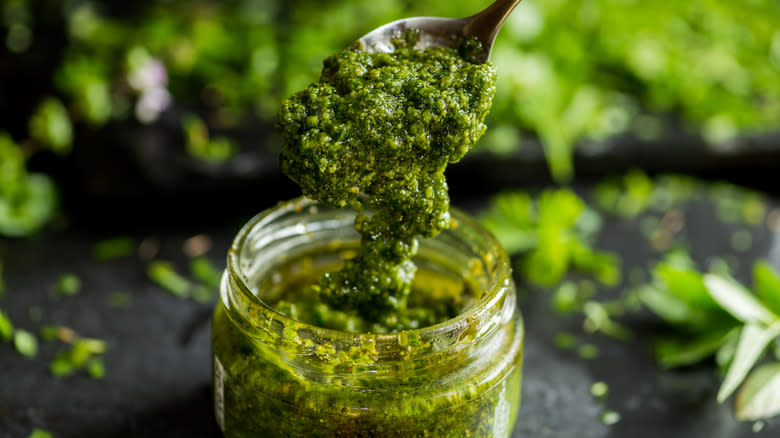
There are plenty of examples of using fresh herbs as the base for a delicious sauce or dressing, and if a classic Italian pesto or green goddess dressing are coming to mind, you are on the right track. Both of these recipes fuse verdant, aromatic herbs with umami-rich ingredients and acid for a recipe that is more or less creamy, but complements a plethora of different dishes.
For a play on this that you can whiz together in a food processor in the blink of an eye, try combining fresh herbs with almond butter, Parmesan cheese, and lemon juice. I recommend using multiple types of herbs for a contrast in flavor. Italian parsley, basil, cilantro, chives, and tarragon are my favorites, but feel free to use whatever you have growing in your herb garden. When it comes to the Parmesan cheese, this is not the time to use that grated stuff in a green can. Go for the real deal and grate it yourself for maximum flavor and texture. If almond butter is not your cup of tea, you can use cashew butter or even tahini to give this recipe some volume.
Greek Yogurt With Feta, Extra Virgin Olive Oil, And Za'atar

Greek yogurt is frequently substituted for mayonnaise in recipes where a creamy texture is desirable. It also contains a hint of tanginess reminiscent of buttermilk, making it an ideal substitution for a dressing that can mimic ranch successfully. Greek yogurt has nutritional advantages as well, being high in protein and rich in gut healthy probiotics, a win-win for those seeking to swap store-bought salad dressings loaded with additives and sugar with something a little more wholesome.
Combining Greek yogurt with feta cheese is a natural fit. It is salty, umami-rich, tart, and has a crumbly texture that can thicken up a dressing beautifully. It is ideal for withstanding more robust lettuces, like romaine or iceberg, and for dipping vegetables, pizza, chicken wings, and more. Lastly, za'atar confers a quintessentially Middle Eastern flavor that will brighten things up. It is a savory spice blend that fuses sesame seeds and dried herbs, like oregano, marjoram, and thyme, with smoky spices, like cumin, and crimson-hued, lemony sumac. Not only does this blend confer complex flavor, the sumac can break up the milky white dressing by infusing it with a pinkish hue.
Cottage Cheese With Lemon, Olive Oil, And Fresh Dill
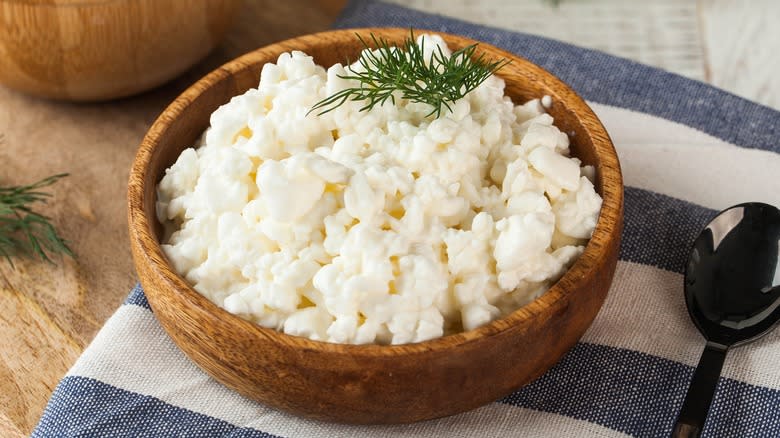
Cottage cheese is high in protein, has a delightfully rich texture that can easily replace mayonnaise in salad dressing, and a tangy flavor that is a suitable facsimile for buttermilk. Some varieties are also rife with gut nourishing probiotics, that we all know we should be eating more of. This combination is perhaps closest to the original ranch in flavor, owing to the lemon juice, olive oil, and fresh dill. It is perfect for any salad, dipping, and dunking to your heart's content.
When making a dressing with cottage cheese, it is important to select a high-quality, small curd, 4% fat content variety from one of the more reputable brands. Characteristics I search for are those that are not overly watered down with whey, which mutes the inherent tart flavor and makes cottage cheese almost soupy in texture. Once you select your cottage cheese brand of choice, simply purée all the ingredients together until smooth in a food processor or blender. For an added boost of flavor and color, you can always pop in some smoked paprika or chili powder, just don't overdo it.
Hummus With Lemon Juice, Oil, And Sumac
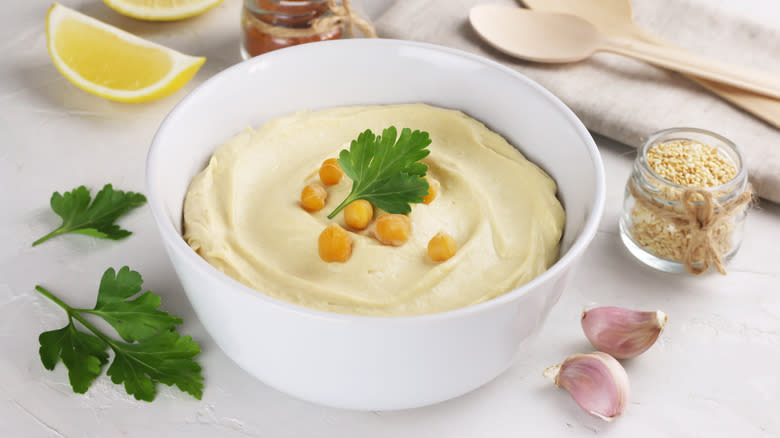
We have already established the benefit of using tahini in salad dressing, but if you want to go a step further along the chain, hummus makes for a spectacular base for salad dressing, and many of us have a container of it in our refrigerators at all times. It comes in many different flavors, but for the sake of salad dressing, I generally use the classic. That said, don't let that stop you. Feel free to flex your creativity muscles and play around with roasted garlic, pepper, or even tapenade varieties, for a boost of extra flavor.
Because hummus has tahini in it, it lends creaminess and nuttiness, while highlighting the buttery, earthy flavor of the chickpeas. The hummus acts as a natural emulsifier akin to mayonnaise in ranch dressing, when blended with olive oil, lemon juice, and seasoned with sumac. If you find the dressing to be too thick, do not overdo the olive oil. There is already oil in the hummus, so you want just enough to loosen the dressing. It can be helpful to purée all of the ingredients together with a hint of ice water to help give it a more velvety and fluffy texture that will work equally as well with delicate greens as it will with vegetables, pizza, or chicken wings.
Avocado With Sour Cream, Lime Juice, And Cilantro

No compilation of substitutions for ranch dressing would be complete without recommending something using avocado as a featured ingredient. Avocado is used in many recipes, both sweet and savory, to help lend velvety texture to everything from brownies and cakes to soups and salad dressings. Its relatively high fat content makes it almost a superhero among fruits and vegetables. Though it is commonly used in Latin-inspired recipes, it is easily adaptable to any type of dish.
The key to using avocados, besides selecting one that is perfectly ripe, is to keep it from turning brown. This can easily be accomplished by incorporating the acid from a citrus fruit, like lime juice. Not only does the citrus prevent the avocado from browning, it provides a bright acidic flavor that, when blended with sour cream and cilantro, is the perfect topping for any salad, vegetable, chip, pizza, chicken wing, and more. When turning avocado into a dressing, you want to fully blend it with a food processor so that it isn't lumpy, like guacamole. This will give it a more pleasurable mouthfeel and help it last longer.
Read the original article on The Daily Meal.


